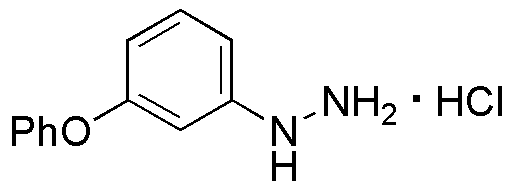(3-Phenoxyphenyl)hydrazine hydrochloride is widely utilized in research focused on
- Pharmaceutical Development: This compound serves as an important intermediate in the synthesis of various pharmaceuticals, particularly in the development of anti-cancer agents. Its unique structure allows for targeted modifications that enhance therapeutic efficacy.
- Agricultural Chemicals: It is used in the formulation of agrochemicals, including pesticides and herbicides. The compound's properties help improve the effectiveness of these products, providing better crop protection.
- Material Science: In the field of polymer chemistry, it acts as a curing agent for epoxy resins, enhancing the mechanical properties and durability of materials used in construction and manufacturing.
- Analytical Chemistry: This chemical is employed as a reagent in various analytical techniques, including spectrophotometry, to detect and quantify specific compounds in complex mixtures.
- Research Applications: It is utilized in biochemical research to study enzyme activity and mechanisms, providing insights into metabolic pathways and potential therapeutic targets.
General Information
Properties
Safety and Regulations
Applications
(3-Phenoxyphenyl)hydrazine hydrochloride is widely utilized in research focused on
- Pharmaceutical Development: This compound serves as an important intermediate in the synthesis of various pharmaceuticals, particularly in the development of anti-cancer agents. Its unique structure allows for targeted modifications that enhance therapeutic efficacy.
- Agricultural Chemicals: It is used in the formulation of agrochemicals, including pesticides and herbicides. The compound's properties help improve the effectiveness of these products, providing better crop protection.
- Material Science: In the field of polymer chemistry, it acts as a curing agent for epoxy resins, enhancing the mechanical properties and durability of materials used in construction and manufacturing.
- Analytical Chemistry: This chemical is employed as a reagent in various analytical techniques, including spectrophotometry, to detect and quantify specific compounds in complex mixtures.
- Research Applications: It is utilized in biochemical research to study enzyme activity and mechanisms, providing insights into metabolic pathways and potential therapeutic targets.
Documents
Safety Data Sheets (SDS)
The SDS provides comprehensive safety information on handling, storage, and disposal of the product.
Product Specification (PS)
The PS provides a comprehensive breakdown of the product’s properties, including chemical composition, physical state, purity, and storage requirements. It also details acceptable quality ranges and the product's intended applications.
Certificates of Analysis (COA)
Search for Certificates of Analysis (COA) by entering the products Lot Number. Lot and Batch Numbers can be found on a product’s label following the words ‘Lot’ or ‘Batch’.
*Catalog Number
*Lot Number
Certificates Of Origin (COO)
This COO confirms the country where the product was manufactured, and also details the materials and components used in it and whether it is derived from natural, synthetic, or other specific sources. This certificate may be required for customs, trade, and regulatory compliance.
*Catalog Number
*Lot Number
Safety Data Sheets (SDS)
The SDS provides comprehensive safety information on handling, storage, and disposal of the product.
DownloadProduct Specification (PS)
The PS provides a comprehensive breakdown of the product’s properties, including chemical composition, physical state, purity, and storage requirements. It also details acceptable quality ranges and the product's intended applications.
DownloadCertificates of Analysis (COA)
Search for Certificates of Analysis (COA) by entering the products Lot Number. Lot and Batch Numbers can be found on a product’s label following the words ‘Lot’ or ‘Batch’.
*Catalog Number
*Lot Number
Certificates Of Origin (COO)
This COO confirms the country where the product was manufactured, and also details the materials and components used in it and whether it is derived from natural, synthetic, or other specific sources. This certificate may be required for customs, trade, and regulatory compliance.

